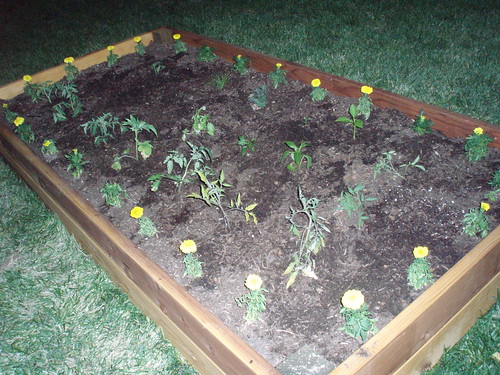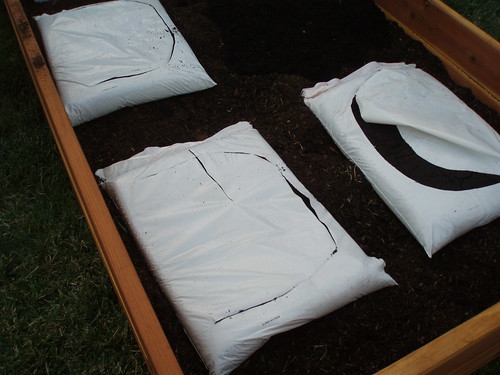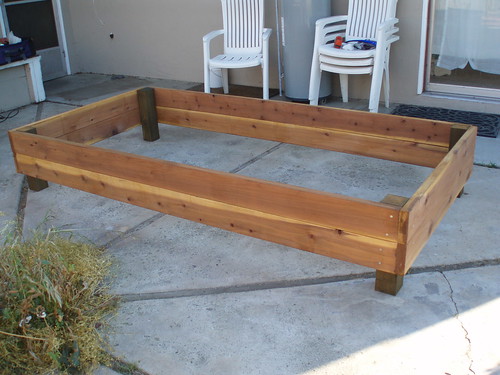 So here it is at long last. I've tried a handful of yeasted breads, and this is the only one I've really had success with. Sandwich bread turned out too dense. This actually has a texture approaching something you'd pay money for in the grocery store.
So here it is at long last. I've tried a handful of yeasted breads, and this is the only one I've really had success with. Sandwich bread turned out too dense. This actually has a texture approaching something you'd pay money for in the grocery store.It starts out, not with Joy, but with Martha. I have a couple tweaks, but really the best is the addition of garlic and rosemary. They're not necessary by any means, but they take plain old bread to a really lovely place. If I haven't mentioned it already, you're almost always going to want to use less garlic than I do in just about any recipe. Unless you're afraid of vampires.
This is a great dinner bread, and goes well with something like pumpkin turkey chilli, or as a crostini for bruschetta with an abundance of summer tomatoes, but we've used it plenty for sandwiches. The shape usually turns out pretty flat, so they're long skinny sandwiches.
We keep two types of olive oil on hand - extra light, which comes in a giant vat from Costco and is used for cooking, and extra virgin, which we buy in a big tin container from the Italian grocery store, and is used for salad dressings. The olive oil is a big part of the flavor here, but it calls for a lot, so I strike a balance between cost and taste by using about half and half.
Olive Oil Bread with Garlic and Rosemary
adapted from Martha Stewart's Baking Handbook
Ingredients
3 3/4 tsp active dry yeast (less than 2 packets; open 2 and measure out)
1 1/2 lbs (4 1/2 cups) bread flour, plus more for dusting
2 scant cups lukewarm water
3/4 cup olive oil
1 tbsp salt
4-5 cloves garlic, minced, or to taste
1 tbsp chopped rosemary
Directions
1. Sprinkle the yeast over the warm water and let sit until dissolved.
2. Meanwhile, in the bowl of an electric mixer, weigh out the flour if you have a scale around. Martha says real bakers measure their flour by weight, not volume, and I think it's helpful with this recipe, which tends towards the wet side. I almost always have to add more flour than 4 1/2 cups.
3. Add the olive oil and water (with yeast) to the flour. Stir with a wooden spoon until incorporated, then cover with plastic wrap and let rise in a warm place until doubled in bulk, about one hour. I use a trick I learned from Joy for a rising cabinet: turn your oven on to 350 or so for one minute, then turn it off. It gets just warm but not hot, and will stay a consistent draft-free temperature better than a countertop.
4. Add the salt, garlic, and rosemary. Mix with the dough hook on low until incorporated, and then up the speed a bit until the dough starts to pull away from the sides. Then turn it out onto a well-floured surface and knead by hand a bit more. Don't be afraid to add flour here if necessary, I almost always do, and flour the board often. Most of the time I'm working with this dough, I'm fighting to keep it from sticking to the board and/or running off it.
5. Return the dough to an oiled bowl, cover again with oiled plastic wrap, and let rise until doubled in bulk, another hour or so.
6. Turn the dough out onto a well-floured work surface and fold into thirds one way, then the other. Turn over, cover with oiled plastic wrap, and let rest 15 minutes.
7. Here, Martha has a bit about a wooden peel and transfering back and forth, and I don't have a wooden peel, which is probably why I never quite get the shape right. I just shape it into a round on my board, by rotating it between cupped hands, and let it sit, covered, for another 30 minutes. At this point, it's time to preheat the oven to 450 degrees. Place a baking stone (or cookie sheet, or upside down jelly roll pan) as close to the floor of the oven as you can get.
8. Make four slashes on top of the loaf to form a square, and place on the baking stone or substitute. This is the part that's easiest with a peel, in large part due to the wet texture of the bread. I usually pick it up in as much of a round as I can manage, and plop it onto the stone as quickly as possible without letting any glop onto the floor of the oven and burn.
9. Bake for about 35 minutes, until crust is dark golden brown. Transfer to a wire rack to cool, then enjoy!














